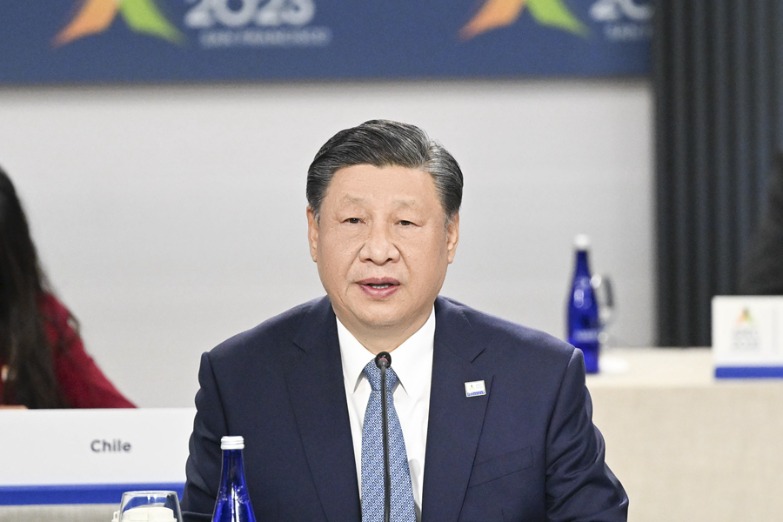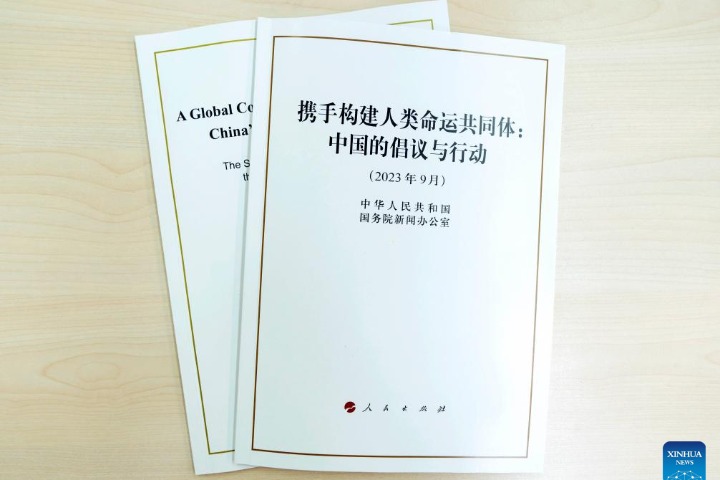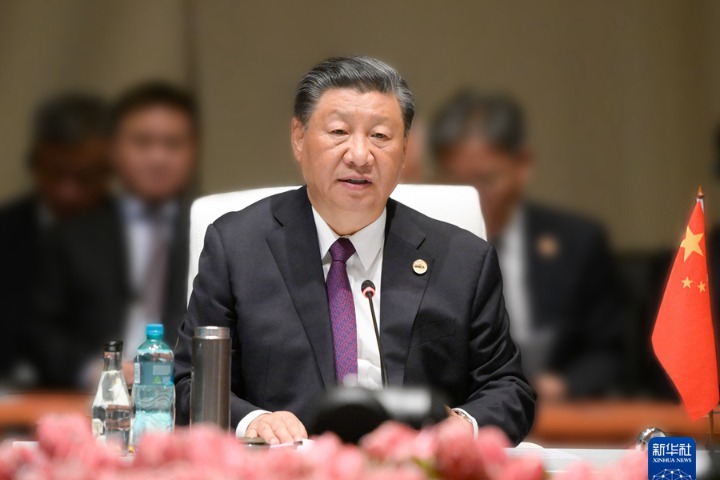《改革开放40年中国人权事业的发展进步》白皮书
新华网 2018-12-13 11:20

二、大幅提升生存权发展权保障水平
II. Better Protecting the Rights to Subsistence and Development
改革开放40年来,中国坚持以生存权和发展权作为首要的基本人权,把发展作为执政兴国的第一要务和解决中国所有问题的关键,以保障和改善民生为重点,努力通过解决最紧迫和最突出的问题增进人民福祉。人民生活总体上实现了从贫困到温饱、从温饱到小康的历史性飞跃。
Over the past 40 years, China has worked to better protect basic human rights, with its primary focus on the rights to subsistence and development. Development is China's top priority in governance and considered to be the key to addressing the country's main problems. China has focused on ensuring and improving people's wellbeing by resolving their most serious and urgent problems, realizing historic leaps from poverty to securing access to food and clothing, and thence to moderate prosperity.
减贫取得历史性成就。消除贫困是中国人权保障的重中之重。改革开放是中国消除贫困的强大驱动力。40年来,中国政府持续开展以农村扶贫开发为中心的减贫行动,在全国范围内开展有组织有计划的大规模开发式扶贫,先后实施《国家八七扶贫攻坚计划(1994-2000年)》《中国农村扶贫开发纲要(2001-2010年)》《中国农村扶贫开发纲要(2011-2020年)》等中长期扶贫规划。中共十八大以来,中共中央把贫困人口脱贫作为全面建成小康社会的底线任务和标志性指标,作出一系列重大部署,以前所未有的力度推进,中国扶贫开发进入脱贫攻坚新阶段。中共中央、国务院发布关于打赢脱贫攻坚战的决定,明确脱贫攻坚的目标标准,确立精准扶贫精准脱贫的基本方略,建立中国特色的脱贫攻坚制度体系,全面推进精准扶贫重点工作。中共十九大提出坚决打赢脱贫攻坚战的战略目标,中共中央、国务院印发关于打赢脱贫攻坚战三年行动的指导意见,把精准脱贫作为决胜全面建成小康社会必须打好的三大攻坚战之一,并庄严承诺确保到2020年中国现行标准下农村贫困人口实现脱贫、让贫困人口和贫困地区同全国一道进入全面小康社会。
Tremendous achievements in poverty reduction. Poverty elimination is the top priority in China's effort to protect human rights. Reform and opening up has been a great driving force for poverty elimination in China. Over the past four decades, the Chinese government has made continuous endeavors in poverty reduction, concentrating on development-oriented poverty alleviation in rural areas. The government has carried out large-scale development-oriented poverty-alleviation campaigns across the country in a planned and organized way, and implemented a number of medium-and long-term programs, including the Seven-Year Program for Lifting 80 Million People Out of Poverty (1994-2000), the Outline for Development-Oriented Poverty Alleviation for China's Rural Areas (2001-2010), and the Outline for Development-Oriented Poverty Alleviation for China's Rural Areas (2011-2020). Since the 18th CPC National Congress, the CPC Central Committee has gone all out to win the battle against poverty, taken poverty elimination as the primary task, made it a defining indicator in building a moderately prosperous society in all respects, and made unprecedented efforts to implement major plans for development-oriented poverty alleviation. The CPC Central Committee and the State Council have issued the Decision on Winning the Battle Against Poverty, which lays out the goals and criteria for poverty elimination, establishes the basic strategy of targeted poverty alleviation and elimination, creates a poverty elimination system with Chinese characteristics, and defines comprehensive efforts to advance key plans for targeted poverty alleviation. In the light of the strategic goal of poverty elimination set out by the 19th CPC National Congress, the central authorities issued a Three-Year Guideline on Winning the Battle Against Poverty. The 19th CPC National Congress defined targeted poverty elimination as one of the three crucial battles in building a moderately prosperous society in all respects, and pledged to help all the rural population living below the current poverty line shake off poverty by the year 2020 and ensure that poor people and poor areas will join the moderately prosperous society together with the rest of the country.
经过多年不懈奋斗,中国农村贫困人口显著减少,贫困发生率持续下降,解决区域性整体贫困迈出坚实步伐,贫困地区农民生产生活条件显著改善,贫困群众获得感显著增强,脱贫攻坚取得决定性进展。据世界银行测算,按照人均每天支出1.9美元的国际贫困标准,过去40年中国共减少贫困人口8.5亿多人,对全球减贫贡献率超过70%。按中国现行贫困标准,1978年至2017年,中国农村贫困人口由7.7亿人减少到3046万人,贫困发生率由97.5%下降到3.1%。2012年至2017年,中国每年有1000多万人稳定脱贫。中国是世界上减贫人口最多的国家,也是率先完成联合国千年发展目标减贫目标的发展中国家。中国的减贫成就是中国人权事业发展的最显著标志。
Through decades of efforts, the number of rural poor has markedly dropped and the poverty headcount ratio has seen a continuous decrease. Solid steps have been taken to eliminate regional poverty, and the working conditions and living standards of the rural poor have notably improved, which created a stronger sense of gain for the people, indicating decisive progress has been made in the fight against poverty. According to World Bank estimates, over the past 40 years, the number of people in China living on less than US$1.9 a day (international poverty line) has dropped by more than 850 million-this represents 70 percent of the total world figure. The number of rural poor fell from 770 million in 1978 to 30.46 million in 2017 when calculated in accordance with China's current poverty line, with the incidence of poverty dropping from 97.5 percent to 3.1 percent. More than 10 million people rose and remained above the poverty level every year from 2012 to 2017. With the highest number of people moving out of poverty, China was the first developing country to realize the UN Millennium Development Goal for poverty reduction. Poverty reduction is the most telling evidence of China's progress in human rights.
温饱问题得到切实解决。改革开放初期,解决近10亿人口温饱问题是中国面临的头等大事。中国改革农村土地制度,实行家庭联产承包责任制,极大激发了农民生产积极性,农业综合生产能力实现质的飞跃。2017年,中国粮食总产量达66161万吨,比1978年翻一番。近年来,中国谷物、肉类、花生、茶叶产量稳居世界第一位,油菜籽产量稳居世界第二位,甘蔗产量稳居世界第三位。中国以不足世界10%的耕地,养活了接近世界20%的人口,从根本上消除了饥饿,持续提升了人民的营养水平,实现了人民的基本生存权。
Adequate food and clothing ensured. In the early days of reform and opening up, providing enough food and clothing for nearly one billion people was the top issue facing China. Reform of the rural land system and the implementation of the household responsibility system greatly stimulated farmers' enthusiasm and boosted agricultural production capacity. China's food grain output reached 661.61million tons in 2017, double the figure of 1978. In recent years China has become the world's largest producer of grain, meat, peanuts and tea, the second-largest producer of rapeseed, and the third-largest producer of sugarcane. China feeds approximately 20 percent of the world's population using less than 10 percent of the arable land, guaranteeing the basic right to subsistence by eradicating hunger and improving nutrition.
饮水安全得到有效保障。实施全国重要饮用水水源地达标建设工程。2016年将600余个供水人口20万以上地表水饮用水水源地及年供水量2000万立方米以上地下水饮用水水源地全部纳入《全国重要饮用水水源地名录》管理,每年开展安全状况评估。2017年评估结果显示,99.5%的水源地供水保证率合格,90.9%的水源地水质合格。实施农村饮水安全工程建设。2005年至2015年,全国累计解决5.2亿农村居民和4700多万农村学校师生的饮水安全问题。2016年以来,实施农村饮水安全巩固提升工程,截至2017年,巩固提升受益人口9509万人,其中,1169万贫困人口的饮水安全问题得到解决,全国农村集中供水率和农村自来水普及率分别达到85%和80%。
Safer drinking water. National standards for major drinking water sources have been implemented. In 2016 more than 600 surface water sources each supplying drinking water for 200,000 people or more, and all ground water sources each supplying 20 million or more cubic meters of drinking water annually were incorporated into the Catalogue of China's Major Drinking Water Sources, subject to annual quality assessment. The 2017 assessment results show that 99.5 percent of the drinking water sources met the water supply reliability standard, and 90.9 percent met the water quality standard. A program was launched in 2005 to ensure drinking water safety in rural areas. By the end of 2015 a total of 520 million rural residents and 47 million teachers and students in rural areas had gained access to safe drinking water. Since 2016 the program has been upgraded to reinforce rural drinking water safety. By the end of 2017 the upgrade had benefitted 95.09 million rural residents, among whom 11.69 million were people living below the poverty line. Centralized water supply now covers 85 percent of the rural population and 80 percent of rural people have access to tap water.
基本居住条件明显改善。改革开放40年来,人民居住条件显著改善。2017年,城镇居民、农村居民人均住房建筑面积分别为36.9、46.7平方米,比1978年分别增加30.2、38.6平方米。国家高度重视解决困难家庭的住房问题。2008年至2017年,全国城镇保障性安居工程累计开工建设约6400万套,通过棚户区改造帮助约1亿人“出棚进楼”;2017年底,3500多万困难群众住进公租房,累计2000多万困难群众领取公租房租赁补贴。中共十八大以来,加大对农村危房改造的支持力度,累计安排1625亿元补助资金、支持1659万贫困农户改造危房,帮助数千万贫困农民告别原来的破旧泥草房、土坯房、树皮房等危房,住上基本安全房。
Improved housing conditions. The past 40 years have witnessed a remarkable improvement in housing conditions. In 2017 the per capita floor space of urban residents was 36.9 sq m, up from 6.7 sq m in 1978, and that of rural residents was 46.7 sq m, up from 8.1 sq m in 1978. The state has made it a priority to resolve housing problems for poor families. From 2008 to 2017 government subsidies were used to build 64 million housing units in urban areas, and redevelopment of run-down areas helped 100 million people move from sub-standard accommodation to new apartments. By the end of 2017 more than 35 million people in straitened circumstances had moved into public rental housing units, and more than 20 million poor people had received public rental subsidies. Since the 18th CPC National Congress the state has increased funding for dilapidated rural housing renovation, allocating RMB162.5 billion in subsidies for renovating the sub-standard housing of 16.59 million rural households, and helping tens of millions of rural households move into proper accommodation from dilapidated houses built of such materials as beaten earth, and timber and bark.
人民出行更加便利安全。40年来,中国交通网络日益完善,有力支撑了经济社会发展,保障人民出行便利安全。截至2017年,全国铁路营业里程达12.7万公里,比1978年增长1.5倍,其中高速铁路达2.5万公里,占世界高铁总量60%以上,高速铁路与其他铁路共同构成的快速客运网基本覆盖全国省会;全国公路总里程达477万公里,比1978年增长4.4倍,其中高速公路通车里程达13.6万公里,公路网密度为49.72公里/百平方公里,是改革开放初期的5.4倍,实现“县县通公路”;全国乡镇和建制村通公路率分别达99.99%和99.98%,农村出行条件持续改善。2001年以来,实施危桥改造、公路安全生命防护和干线公路灾害防治三项工程,共改造乡道及以上公路危桥3.9万座,完成66万公里高风险段整治,改造地质灾害易发路段3.1万公里,使出行安全更有保障。完成8440个空白乡镇邮政局所补建,全国总体实现“乡乡设所,村村通邮”。快递乡镇网点覆盖率超过87%,搭建了“工业品下乡、农特产品进城”的双向大通道。
More convenient and safer public transport. Over the past 40 years China's steadily-improving public transport network has provided stronger support for the country's economic and social development, and greater convenience and safety to the public. By the end of 2017 China's rail network had grown to 127,000 kilometers, up by 150 percent from 1978, and high-speed rail had reached 25,000 kilometers, accounting for more than 60 percent of the world's total. The high-speed and other railway lines form an extensive passenger transport network covering all provincial capitals in the country. By the end of 2017 China's road network had increased to 4.77 million kilometers, up by 440 percent from 1978, including 136,000 kilometers of expressways. Road density had grown more than fivefold from the beginning of reform and opening up to 49.72 km/100 sq km. Every county in China now has access to roads. Rural transport has seen continuous improvement, with roads connecting 99.99 percent of towns and townships and 99.98 percent of administrative villages. Since 2001 programs have been carried out to renovate dangerous bridges, and reinforce road safety, the protection of the public, and road disaster prevention. Through these programs, 39,000 bridges on roads at township level and above, 660,000 kilometers of high-risk roads, and 31,000 kilometers of disaster-prone roads have been renovated to better safeguard public transport safety.A total of 8,440 new post offices have been built in towns and townships, with the result that every township-level unit has a post office and every village has access to postal services. Express delivery outlets cover 87 percent of towns and townships, establishing a two-way channel that facilitates the transport of manufactured products to rural areas and agricultural products to the cities.
生命健康权保障水平大幅提升。改革开放特别是中共十八大以来,健康中国建设加快推进,为人民提供全生命周期的卫生与健康服务。中国人均预期寿命从1981年的67.8岁提高到2017年的76.7岁,高于72岁的世界平均预期寿命。孕产妇死亡率从1989年的十万分之94.7下降到2017年的十万分之19.6,婴儿死亡率从1991年的50.2‰下降到2017年的6.8‰,提前达到联合国千年发展目标所确定的指标要求。覆盖城乡的基层医疗卫生服务体系基本建成。2017年全国共有医疗卫生机构98.7万个,比1978年增长4.8倍;卫生技术人员898万人,比1978年增长2.6倍。国家基本公共卫生服务项目持续推进,适龄儿童国家免疫规划疫苗接种率达90%以上,5岁以下儿童乙肝病毒表面抗原携带率降至1%。建成全球最大的法定传染病疫情和突发公共卫生事件网络直报系统,平均报告时间缩短到4小时。全民健身运动蓬勃发展,全国体育场地总数超过170万个,人均体育场地面积超过1.6平方米。
Better protection of the rights to life and health. Since reform and opening up, and especially since the 18th CPC National Congress, the country has increased public access to health services throughout the life cycle, to quicken its pace toward a healthy China. Life expectancy in China rose from 67.8 in 1981 to 76.7 in 2017, higher than the world average of 72. The maternal mortality rate decreased from 94.7 per 100,000 in 1989 to 19.6 per 100,000 in 2017, and the infant mortality rate dropped from 50.2 per 1,000 in 1991 to 6.8 per 1,000 in 2017, both meeting the UN Millennium Development Goals ahead of schedule. A community-level health service system covering urban and rural areas is in place. The number of health service institutions increased to 987,000 in 2017, up by 480 percent from 1978, with the number of health professionals growing by 260 percent to 8.98 million in 2017. Basic public health services have improved, with national vaccination coverage among children topping 90 percent, and the prevalence of HBsAg in children under five decreasing to 1 percent. China has set up the world's largest online direct reporting system of notifiable epidemics and public health emergencies, and the average reporting time has been shortened to four hours. The national fitness program has thrived, with more than 1.7 million sports venues across the country.
社会救助力度不断加大。经过多年发展,中国的社会救助形成了以最低生活保障、特困人员救助供养、灾害救助、医疗救助、住房救助、教育救助、就业救助以及临时救助为主体,以社会力量参与为补充的制度体系。在全国范围内建立最低生活保障制度,颁布《城市居民最低生活保障条例》《社会救助暂行办法》等。国务院出台关于进一步健全特困人员救助供养制度的意见,将城市“三无”人员救助和农村“五保”供养统一为特困人员救助供养,保障城乡特困人员基本生活。截至2017年,全国共有37494个乡镇(街道)设立经办社会救助事务的机构,从事社会救助的专(兼)职工作人员为104673名,平均每个乡镇(街道)2.6人。截至2018年9月,全国共有城乡低保对象4619.9万人,其中,城市低保对象1068.8万人,平均城市低保标准为每人每月575元,农村低保对象3551.1万人,平均农村低保标准为每人每年4754元,所有县(市、区)的农村低保标准全部达到或超过国家扶贫标准。2017年,全国共实施医疗救助9138.1万人次,其中,直接救助3517.1万人次,资助困难群众参加基本医疗保险5621万人。2018年1月至9月,全国共实施临时救助565.8万人次,平均救助水平1069.4元/人次。
Expanded social assistance. Through years of effort, China has formed a social assistance system with subsistence allowances, assistance and support for people in extreme difficulty, disaster relief, medical assistance, housing assistance, education assistance, employment assistance, and temporary assistance as the main forms, supplemented by public participation. A subsistence security system has been set up nationwide. Regulations on Subsistence Security for Urban Residents and Interim Measures for Social Assistance have been enacted. Decisions on Improving the Assistance and Support System for People in Extreme Difficulty provide assistance to two groups of people-urban residents without income, the ability to work, or support by family, and rural people eligible for the "Five Guarantees": those who are unable to work and have no source of income, including the elderly, the disabled and minors who have no legal guardians to support them. By the end of 2017, 37,494 towns, townships and neighborhoods had set up social assistance agencies, staffed by 104,673 full-time and part-time personnel-an average of 2.6 per unit. As of September 2018 there were 46,199,000 people living on subsistence allowances, consisting of 10,688,000 urban residents receiving an average of RMB575 per month, and 35,511,000 rural residents receiving an average of RMB4,754 per annum. All rural subsistence allowance standards at the county level meet or exceed the national poverty line. In 2017 medical assistance was granted to 91,381,000 applications, in the form of direct payment for medical service for 35,171,000 people, and as subsidies for 56,210,000 poor people when joining the basic medical insurance. Between January and September 2018 temporary assistance was given to 5,658,000 applications, averaging RMB1,069.4 per application.
环境权利保障日益加强。改革开放40年来,中国将生态文明建设纳入国家发展总体战略,对生态环境的治理力度不断加大,生态环境状况总体持续好转,人民群众的环保权益得到有效维护。1979年,通过第一部环境保护法。1982年,首次将环境保护作为独立篇章纳入国民经济和社会发展计划。1983年,将保护环境确定为基本国策。1994年,通过《中国21世纪议程》,成为世界上第一个制定实施本国可持续发展战略的国家。中国坚持绿色发展理念,以前所未有的力度治理环境污染,推进生态文明建设,美丽中国建设迈出重要步伐。中共十九大明确提出打好污染防治攻坚战的重大战略部署,全国生态环境保护大会正式确立习近平生态文明思想,中共中央、国务院印发关于全面加强生态环境保护坚决打好污染防治攻坚战的意见,明确了打好污染防治攻坚战的时间表、路线图、任务书。2017年,煤炭在中国能源消费中的比重为60.4%,比1978年下降10.3个百分点;天然气、水、核、风、电等清洁能源消费比重从1978年的6.6%提升至2017年的20.8%。2017年,全国338个地级及以上城市可吸入颗粒物(PM10)平均浓度比2013年下降22.7%,74个重点城市细颗粒物(PM2.5)平均浓度比2013年下降34.7%。2017年,全国完成造林面积736万公顷,森林覆盖率达21.66%;建成2750处自然保护区,总面积147万平方公里,约占陆地国土面积的14.86%。中国积极参与全球环境治理,已批准加入30多项与生态环境有关的多边公约或议定书,率先发布《中国落实2030年可持续发展议程国别方案》,向联合国交存气候变化《巴黎协定》批准文书,成为全球生态文明建设的重要参与者、贡献者、引领者。
Stronger protection of environmental rights. Over the past four decades China has incorporated ecological progress into the national development strategy and intensified its efforts in environmental governance, creating a better environment and effectively safeguarding people's environmental rights. China's first Environmental Protection Law was adopted in 1979. Environmental protection was first included as a salient part of the plan for national economic and social development in 1982, and was designated as a basic state policy in 1983. China's Agenda 21 passed in 1994 made China the first country in the world to formulate and implement a strategy of sustainable development. Committed to green development, China puts an enormous effort into pollution control and takes concrete steps to promote ecological progress toward a beautiful China. The 19th CPC National Congress sounded a clarion call to win the battle against pollution. The National Conference on Environmental Protection established Xi Jinping Thought on ecological progress. The CPC Central Committee and the State Council issued the Decisions on Comprehensively Strengthening Environmental Protection and Resolutely Winning the Battle Against Pollution, setting out the timetable, road map and agenda for pollution prevention and control. In 2017 coal accounted for 60.4 percent of China's total energy consumption, down by 10.3 percentage points from 1978. The proportion of clean energy sources, including natural gas, water, nuclear, wind and electricity, has increased from 6.6 percent in 1978 to 20.8 percent in 2017. Between 2013 and 2017, the average PM10 intensity in 338 cities at and above the prefecture level nationwide fell by 22.7 percent, and the average PM2.5 intensity in 74 major cities fell by 34.7 percent. In 2017, trees were planted on 7.36 million hectares across the country and forest coverage was 21.66 percent; the number of nature reserves totaled 2,750, covering 1.47 million sq km or 14.86 percent of China's land territory. China has played an active role in global environmental governance, and ratified more than 30 multilateral conventions and protocols related to environmental protection. China was the first country to release a national plan on implementing the 2030 Agenda for Sustainable Development and to deposit its instrument of ratification for the Paris Agreement, becoming an important participant, contributor and leader in promoting global ecological progress.

















 英语点津微信
英语点津微信 双语小程序
双语小程序